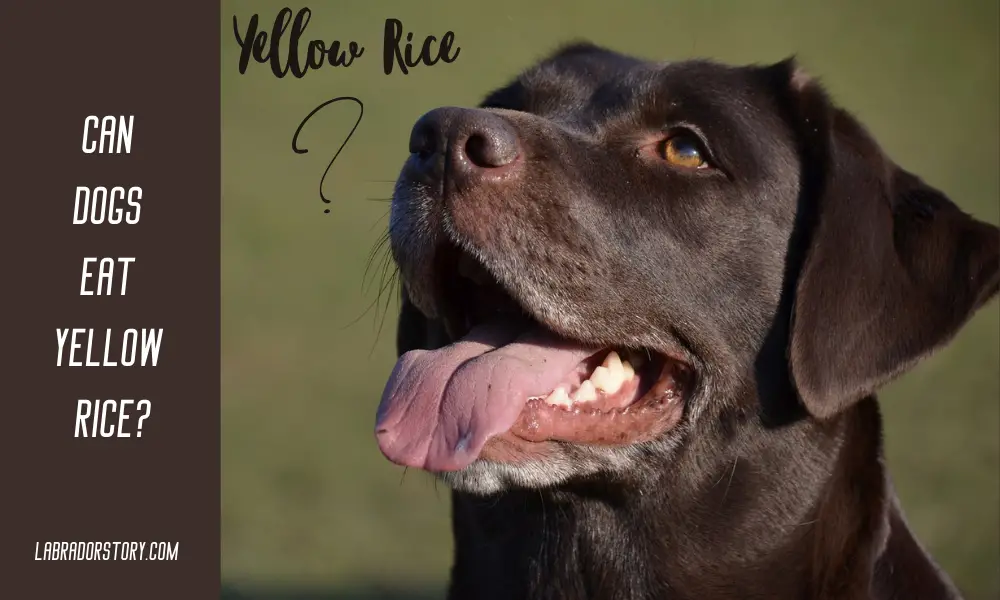Last Updated on January 24, 2024 by Linda Richard
Hi my name is Linda Richard, and I am continuing my series on what foods you can serve your four-legged friends and which ones are best not to. I look at the important factors and make recommendations based on my personal experience and consultation with leading experts. Today I want to talk about: Can dogs eat yellow rice?
Veterinarians and zoo nutritionists often ask pet owners, “Can dogs eat yellow rice?”. The answer is YES, but if garlic and onion powder was not used in its preparation. By the way Curcuma and Saffron they do not carry negative consequences on the dog’s health. While some furry pet owners often think that dogs are exclusively carnivores, veterinarians point out that our furry friends are omnivores. Dogs need a balanced diet of both plant and animal foods – too much pure meat protein can cause kidney and liver problems.
I have a wonderful Labrador Retriever and I know from experience that giving “human” food can be given as a small encouragement, but there are always a number of factors and risks to consider. I particularly want to mention foods that seem safe at first glance, but actually contain ingredients or additives that are dangerous to a dog’s health.
Table of Contents
What is Yellow Rice, Composition, Benefits and Harm to the Dog
Rice becomes yellow when cooked with turmeric or saffron, a popular way to serve rice in many countries. Spanish yellow rice is a staple dish for many Latin American cooks. In Indonesia, yellow rice is prepared for birthdays and other celebrations, and is traditionally laid out in a cone shape on a plate before serving. Various aromatic spices are added to Indian yellow rice.
Let’s break down the main ingredients that are used to make yellow rice. Also in the table I will present you how safe they are for your four-legged friend.
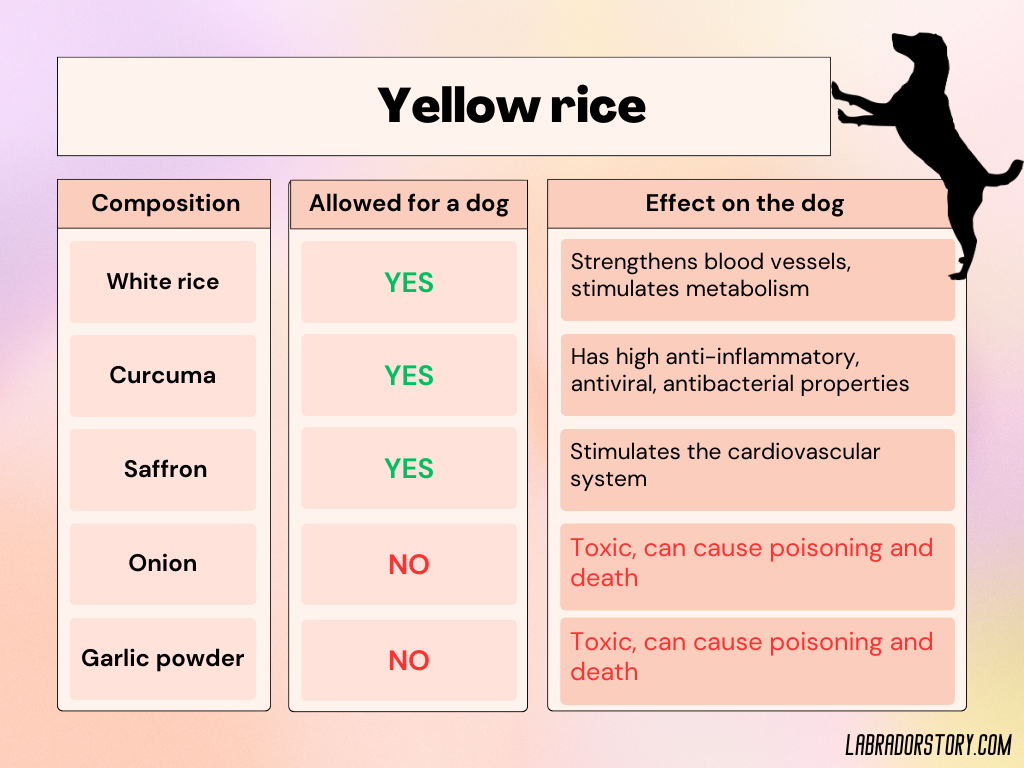
How Healthy is White Rice for Dogs in General
The basis of the diet of pets is meat, a source of protein. The second most important component of the diet is cereals, a source of carbohydrates and fiber. Next come fats, vitamins, minerals and other useful substances.
Rice is a cereal crop from which cereal and starch are produced. It is a source of complex carbohydrates, vitamins B and E, carotene, 8 amino acids, as well as iron, potassium, zinc, phosphorus, calcium and iodine. Rice cereal is known for its dietary and hypoallergenic properties. Thanks to complex carbohydrates, the nutritional properties of rice are quite high, but it is not caloric. And here gluten, unlike other grains, it has very little. Accordingly, there is no allergy to vegetable protein.
Here are the health benefits of feeding rice to your dog:
- Rice is a low-fat product
- It is low in sodium
- It contains antioxidants that protect against disease and cognitive impairment in aging pets
- Levels of calcium, phosphorus and vitamin D support bone health
- Calms gastrointestinal disorders
- Its probiotic action nourishes beneficial bacteria found in the small intestine
- The fiber in rice supports regular intestinal peristalsis and improves digestion
- The high carbohydrate content boosts energy levels and improves cognitive function
- Because rice bran contains nutrients, brown rice is rich in vitamins and minerals and is the healthiest addition to your dog’s diet.
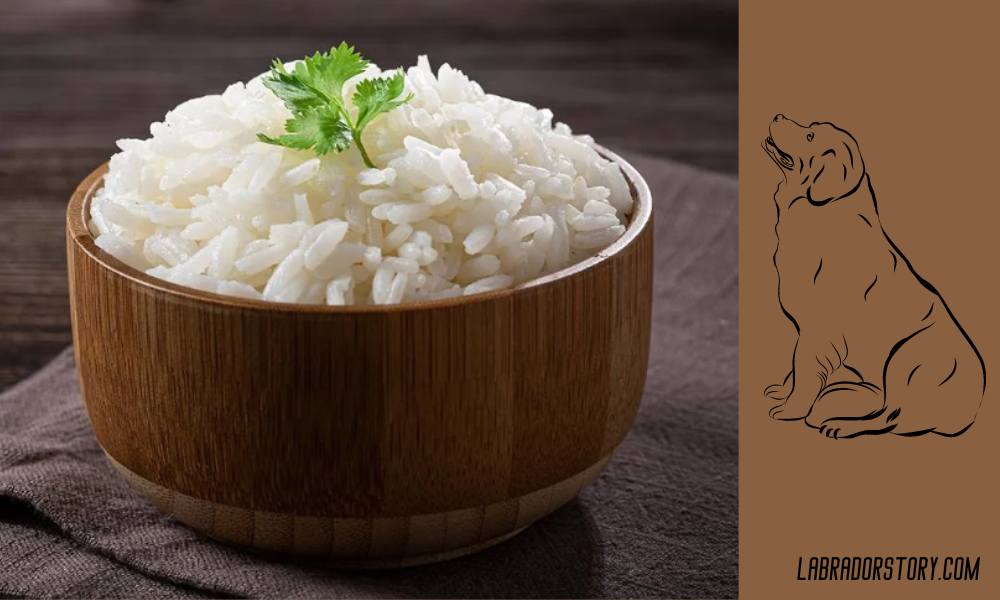
Read also: Can Dogs Eat Graham Crackers?
Curcuma is a Healthy Spice for Your Dog
Curcuma is a widely used spice known for its health benefits, and now it can be good for man’s best friend – the dog! This yellow-orange root has anti-inflammatory properties and acts as an antioxidant, which means it can help protect your pup from free radical damage. If you mix turmeric with black pepper and some source of fat to help the body absorb it better, it can ease joint discomfort and improve your furry companion’s digestion. If you follow the directions carefully and consult your veterinarian beforehand, there’s no reason not to add this ingredient to your pet’s diet!
Curcuma is a powerful antioxidant, and antioxidants can slow aging, degeneration, and even increase longevity. Oxidative stress builds up over time in your dog, much like rust. It causes damage to cells, proteins, and DNA in your dog’s body.
I have personally introduced turmeric into my dog’s diet on a regular basis as the benefits are tremendous. But before doing so, I consulted my veterinarian!
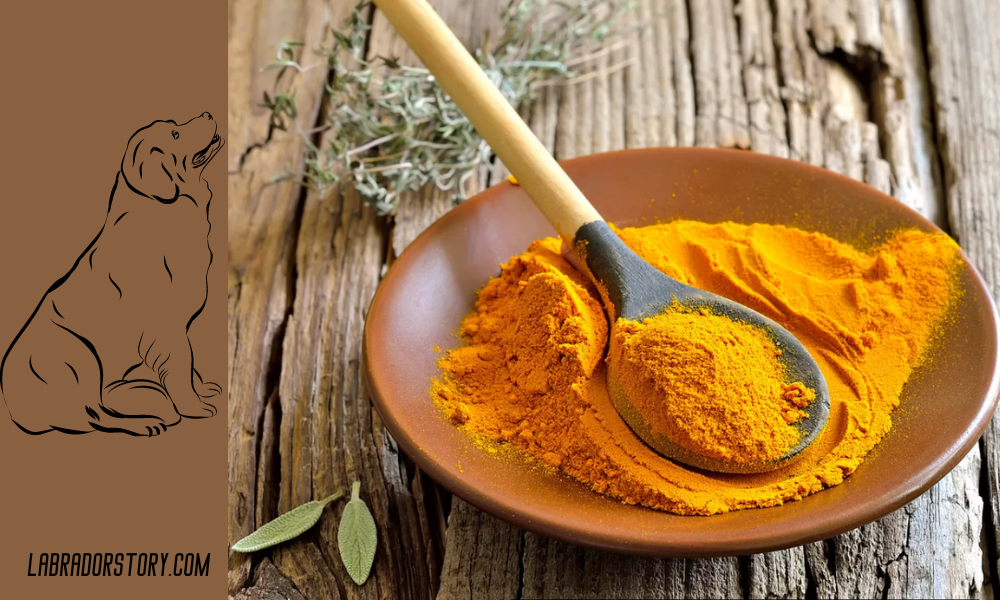
Saffron is One of the Most Expensive Spices in the World
Saffron is one of the most expensive spices in the world. Saffron contains vitamins A, C, PP, almost all of the B group, calcium, potassium, flavonoids and carotenoids, essential oils, gum and nitrogenous substances.
Hippocrates and Asclepius wrote about the beneficial properties of saffron and its use for medicinal purposes. Avicenna presented saffron as a unique plant for the treatment of such diseases as depression, labor difficulties, respiratory failure and digestive disorders. Saffron stimulates the cardiovascular system; participates in the purification of blood, lymph and blood vessels from cholesterol; is taken to relieve inflammation; decoctions help to relieve swelling and fight intestinal cramps; stimulates immune system enhancement.
For our four-legged friends saffron also carries only positive properties. Especially if you take into account that its amount in yellow rice is not significant at all. So if Saffron was used in the preparation of Yellow Rice, it is good for your dog’s digestion.
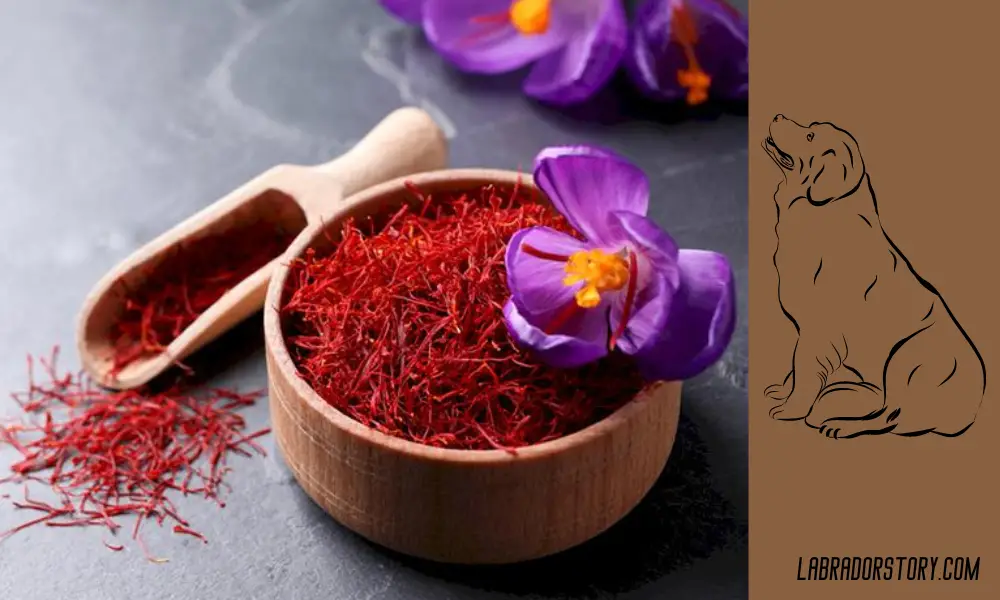
Onion and Garlic Powder are TOXIC to your DOG!
Why are onions and garlic bad for dogs? The fact is that both onions and garlic contain so-called N-propyl disulfide. This compound damages the oxygen-carrying substance found in red blood cells (hemoglobin). The red blood cells begin to actively break down. This condition, called hemolysis, leads to anemia, which we can diagnose by the deep red or brown color of the pet’s urine. In severe cases, anemia leads to severe internal organ damage, multi-organ failure, and even death. So, if your pet has eaten some onion or garlic by mistake, the easiest thing he can get away with is gastrointestinal irritation.
What dosage of onions and garlic would be dangerous for a dog? Accurate scientific studies conducted on this subject have yielded the following results: 15 to 30 g per kg of weight in dogs resulted in clinically significant hematologic changes. Onions become toxic when consumed at 0.5% of the animal’s weight; in general, a dose of a quarter cup of onions is dangerous for the average dog. Consuming onions and garlic as spices included in dishes is also dangerous. So, if you love onions and garlic and often feed your dog from your table, this dietary regimen can pose a serious danger to your pet.
What are the symptoms of poisoning? Clinical forms of poisoning may appear within a day after consuming a dangerous dose of onions and garlic. In some cases, this period extends to several days.
The main symptoms are lethargy, weakness, poor coordination of movements, pale gums, vomiting or diarrhea, rapid heartbeat and/or breathing, red or brown urine, and increased salivation.
If you see your dog eating onions or garlic, or a dish that contains large amounts of these foods, you can try to induce vomiting within 30 minutes. To do this, pour a half teaspoon of table salt on the root of the tongue for small breeds and a tablespoon for large breeds, followed by a small amount of water. Vomiting should occur within 20 minutes. If the exact time of eating these foods is not known, you should give your pet adsorbents. After providing first aid, immediately go to the veterinary clinic, where the animal will be examined.
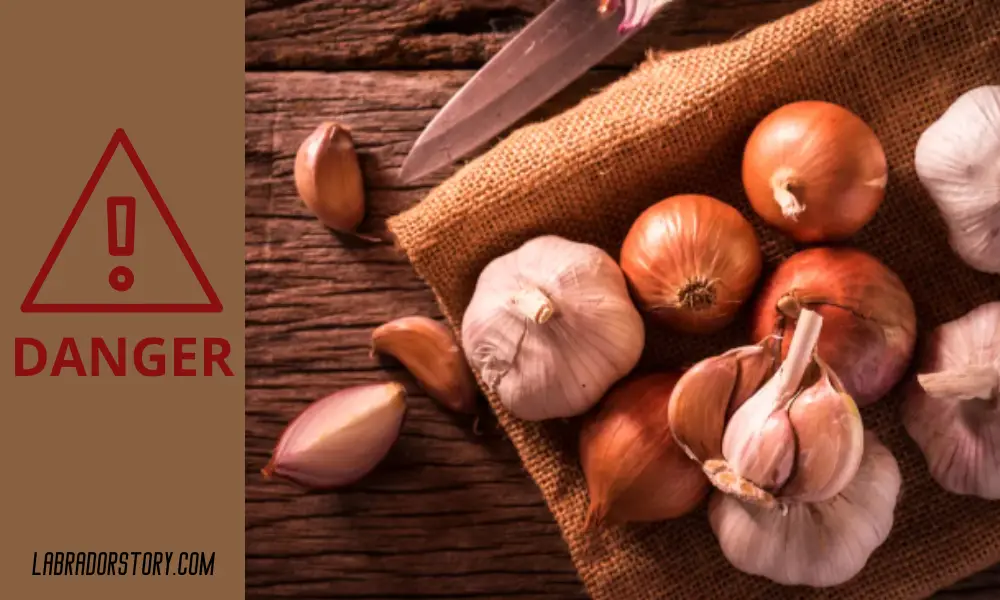
A Recipe For Delicious and Healthy Yellow Rice For Dogs
I have already told you about the benefits of rice in a dog’s diet and now I want to share with you my recipe for healthy and proper yellow rice that I cook for my dog. As you already understand this recipe does not contain any harmful ingredients, so it has maximum benefits and no risks for your pet!!!!
But I want to remind you that some dogs may be allergic or intolerant to rice and other foods. If your dog suffers from allergies, it’s always a good idea to talk to your veterinarian before introducing a new food. Yeast allergies can be particularly problematic if you want to feed your dog rice.
Signs of an intolerance or allergy to rice include:
- Vomiting
- Itchy skin
- Inflamed paws (Read more details here) or constant licking of the paws
- Dry skin
- Skin rashes
- Hair loss
How Much Yellow Rice can I Give my Dog?
Dogs need a complete and balanced diet. Most dog foods contain the correct daily amount of calories and nutrients your dog needs for optimal health. This means that your dog’s rice intake should never exceed 10 percent of his daily serving. If you give your pet more than 10 percent, you run the risk of increasing her weight or increasing her risk of diabetes.
Large dogs can eat about ⅓ of a serving of rice two or three times a week. Small dogs should eat much less. Remember that these recommended amounts are for dogs on a balanced dog food, with rice served as a treat or as an additional ingredient in their daily diet.
Give small portions at first and then gradually increase the serving size if your dog shows no signs of digestive problems.
Conclusion
In this article, I hope I have given you the most important and useful information possible. And I have answered the main question: Can dogs eat yellow rice!
Of course dogs can eat yellow rice, but if garlic and onions, as well as a lot of vegetable oil and spices were not used in its preparation. It is ideal if you cook yellow rice for your dog! A useful recipe of which, I have written to you!
Let your pet be healthy and happy!
